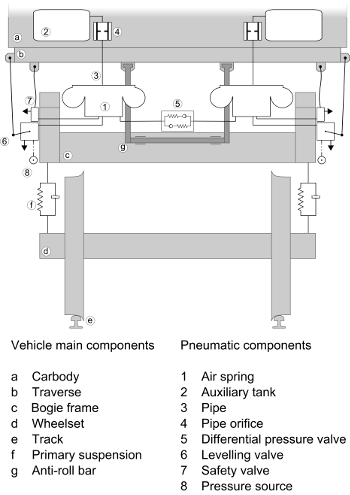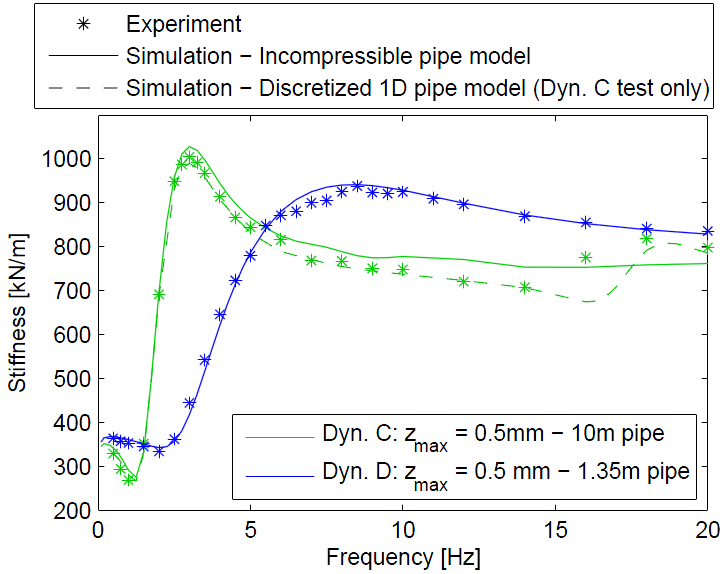
Most of passenger trains are equipped with pneumatic suspensions. Such a system allows to adapt the suspension height and stiffness to a varying payload and provides better comfort and sound insulation. However, in order to achieve these interesting properties, the air suspension involves a complete pneumatic circuit composed of auxiliary tanks, pipes, restriction orifices and several valves. These various components can be combined in many ways leading to an increasing design complexity. From an industrial point of view, resorting to a simulation tool could be very beneficial in designing more efficient suspensions.

Multibody dynamics is certainly a powerful way to model railway vehicles. Many developments were performed and railway specific features such as the wheel/rail contact problem were implemented in commercial multibody packages. They are now widely used in the industry to design vehicles and analyse their performances, for example, in terms of comfort and safety. However, suitable tools to study the behaviour of the overall pneumatic suspension circuit are still lacking. This research activity therefore aims at analysing the existing pneumatic suspension models and proposing a modelling approach that involves most of the pneumatic circuit elements and that can be coupled with multibody dynamics. The goal is both to be able to address industrial problems and to provide an in-depth understanding of the physical phenomena that occur in the system.
Pneumatic suspension modelling
Various modelling approaches for the pneumatic circuit has been compared on a given test case is described. A component oriented approach based on thermodynamics has been developed, focusing on pipes for which several methods have been investigated. It has been shown how the chosen equations affect the frequency response of the suspension.
Then, experiments have been carried out on a real suspension. A system composed of an air spring connected to an auxiliary tank has been submitted to various kinds of excitation and various configurations of the connecting pipe are tested. After determining the model parameter of the suspension, the influence of heat transfer phenomena has received a particular attention. The dynamic response of the suspension has been tested and experimental measurements has been confronted to simulation results.

Finally, thanks to the developped models, a complete metro car and its pneumatic circuit have been implemented. The complete vehicle performances has thus been analysed for tests in which components such as valves play an important role. In particular the impact of some suspension component failure has been investigated. Several pneumatic circuit morphology have been compared and novel topology have been proopsed.
In this project, we have shown how the failure modes of the pneumatic suspension of a metro car can be analysed using computer models. The modelling approach is explained in details in the Pneumatic Suspension modelling project: it relies on the mass and energy balance equations for the air springs and the tanks and on mass flow formulations for the pipes and the valves. The pneumatic model of the suspension was coupled to a multibody model of the vehicle using a co-simulation approach in order to analyse and to understand the behaviour of the whole vehicle when a leakage appears in the pneumatic circuit. In particular, the wheel unloading has been calculated for more or less important leakages and it has been shown that the most critical case does not correspond to the largest leakage.
This approach is not limited to a specific failure mode and it can be applied to several situations such as:
For instance, the safety of the vehicle can be assessed if the failure occurs when passing through a curve. However, the large number of possible combinations makes this work tedious. Nevertheless, such an analysis should be perform as soon as possible in the design process of the suspension. This is why the present approach is used forestablishing the feasibility of novel suspension design inspired from an automotive suspension design which has shown promising results for railway application. The robustness of this solution with respect to failure mode has now to be checked to guarantee the possibility of a practical implementation.
Docquier N., Multiphysics Modelling of Multibody Systems: Application to Railway Pneumatic Suspensions, PhD thesis, Université catholique de Louvain, 2010.
Docquier N., Fisette P., Jeanmart H., Multiphysic modelling of railway vehicles equipped with pneumatic suspensions, Vehicle system Dynamics, 2007, 45, 6, pp. 505-524.
Docquier N., Fisette P., Jeanmart H., Model-based evaluation of railway pneumatic suspensions, Vehicle System Dynamics, 2008, 46 (SUPPL.1), pp. 481-493